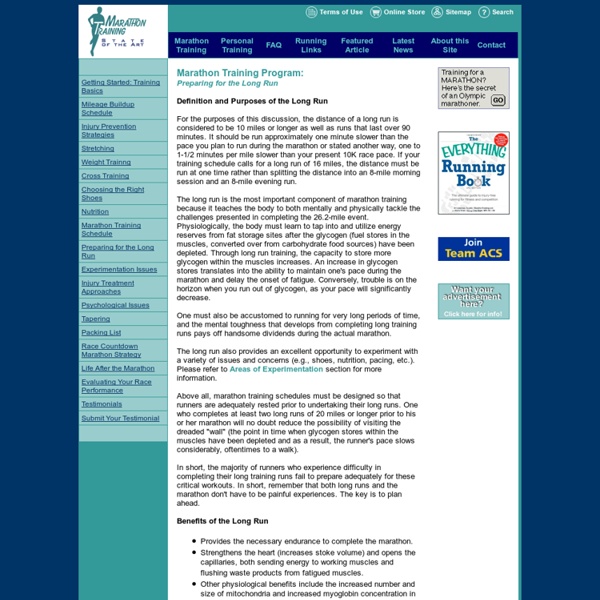| Land Stewardship Centre of Canada
Subtopics: Alberta Agriculture and Rural Development catalogue of books, DVDs and CD-ROMs contains over 75 titles that are essential for today’s farmers and ranchers. They provide up-to-date information on a wide range of agricultural and horticultural practices. These books may be purchased from Alberta Agriculture and Rural Development’s Publications Office in Edmonton by calling 1–800-292–5697 (toll-free in Canada) or 780–427-0391. Published: June 2009 Updated: August 2010 Mission: to serve the people of Alberta by providing an efficient distribution service for departmental publications.
Running Shoes, Marathon Training, Running Tips & Nutrition – Competitor.com
Running Warehouse: Run Like a Kenyan
Simple strategies to train like the world's best runners by Scott Douglas Wouldn't it be great to run like a Kenyan? Okay, so you're probably not going to move to 8,000 feet of altitude and devote yourself entirely to your athletics. One hundred twenty-mile weeks might not be on next week's agenda. I spent December 2004 in Iten, Kenya, the country's unofficial running capital, where Olympic medalists, world champions and international marathon winners train. Start Slow, Finish Fast Every run I did with Kenyans started at a stumble, and most finished substantially faster. Think of a pot of water coming to a boil-there's no one instant where you can pinpoint when it started to get hot, but the end result is undeniable. Vary Very Much One day I joined 12:52 5K man Isaac Songok and world junior cross country champ Augustine Choge for their morning run. This great disparity in intensity level from run to run is common. Get With a Group Tread Softly Hit the Hills Not at all. Run Diagonally Do Drills
Shin splints treatment - exercise to strengthen the lower legs, prevent, repair and care for shin splints problems. | Sports Injury Bulletin
When you decided to get really serious about your training earlier this year, everything went smoothly for several weeks, but one day you felt a dull ache on the inside, lower portion of your shin as you began your workout. The discomfort went away once you had warmed up, so you weren't overly concerned. Unfortunately, the pain returned on the following day - and lasted for a longer portion of your workout. As the days went by, pain was present for the whole training session, as well as your cool-down - and even hung around during your regular daily activities. ================================================= More information on Shin Splints:All of our articles on shin splints Medial tibial stress syndrome - Two quick fixes for shin splints Shin splints: The runner's disease Q&A - What can I do to heal Shin Splints? Q&A Shin splints or stress fracture? Got a question about shin splints? What was wrong? The sound of slapping feet Try these MTSS-preventing exercises 1. Now the single-leg raise
Net-Zero SIPs Laneway House with Solar
When I first mentioned the Mendoza Laneway House, it was one of the first laneway homes in Vancouver under the city’s EcoDensity program. The company behind that efficient SIPs home, Lanefab, and its partners, designer Bryn Davidson and builder Mat Turner, have been busy and recently completed the first Net-Zero Solar Laneway House on a corner lot at 57th and Vivian. It’s beautiful inside and out. The home features a warm exterior palette of black rock stucco and cedar and was built with triple-glazed Cascadia windows, 1′ thick SIPs, and 18′ multi-fold doors that create a nice connection between the great room and the outdoor patio. Other green features include LED lighting (95% of all lighting), a 500-gallon rainwater collection tank, WaterCycles drain water heat recovery, a Venmar high-efficiency HRV, an air-source heat pump for space heating and water, and a Cent-a-Meter whole house energy monitor. The home has one bedroom, two bathrooms, and 1,020 square feet.
10 Signs That You Need a Rest Day From Runner
After disappointing performances in a couple of key tune-up races last fall, a depleted Ryan Hall made the hard decision to withdraw from the Chicago Marathon. Too many grinding 15-mile tempo runs at a five-minute-per-mile pace at 7,000 feet with too little rest afterward had finally caught up with him. "I love to push my body," he says. "Recovery is the hardest part of training for me." Problem is, if you don't take time for proper R&R, your body won't adapt to the stress of your training—you won't get stronger or faster, explains Stacy Sims, Ph.D., at the Stanford Prevention-Research Center, School of Medicine. First, your sleep patterns and energy levels will feel the effects. So in preparation for the 2011 Boston Marathon, Hall used an online recovery-tracking program called Restwise, which looks at simple biological markers input by the athlete first thing each morning, calculates a daily recovery score from 1 to 100, then trends it over time. Does Form Matter? Moving On
How to Get a Complete Workout with Nothing But Your Body
How To Breathe When Running | Complete Running Network
Posted by Mark Iocchelli Filed Under: Our Best Running Articles, Running Tips ‘How to breath properly while running’ is one of the most searched for topics here at Complete Running. This article contains tips and video to show you the correct way to breathe while running. Out of Breath? It’s important to remember that, if you run out of breath, become dizzy or nauseous, it means you are not taking in enough oxygen for the speed you are running. 7 Key Breathing Tips Try slowing down before attempting to change your breathing.Focus on longer, deeper breaths.Breath more from your diaphragm (belly) than your chest (chest breathing is more shallow).Focus on exhaling more fully. Following these tips should make breathing easier, and your runs more enjoyable. Happy running! Videos About Mark Iocchelli Also known as the "Running Blogfather", I'm a 40-something marathoner who has beaten stress fractures and terrible shin splints.
Autonomous Community Support Network - Community Support Network



